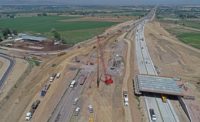The Regional Transportation District's (RTD) FasTracks program—the largest transit expansion in the country—has stimulated the Denver metro area's economy ever since construction began in January 2005. From then until last September, RTD estimates that the program injected $2.2 billion into the local market while providing 9,400 direct jobs at the height of construction and 7,000 to 8,000 indirect jobs.
"This project is an economic driver benefiting communities all over the region," says RTD general manager Phil Washington. "We're moving very rapidly to get all of this built."
Approved by voters in 2004, the ambitious FasTracks program is set to build, over 12 years, more than 122 miles of rail transit. The program includes six new commuter rail and light rail lines and extensions of three existing lines, as well as 18 miles of bus rapid transit service along U.S. 36, the main artery between Denver and Boulder.
Of those 140 collective miles, 81 miles are currently under construction or under contract. One key component, the $500-million redevelopment of Denver Union Station, is set for a 2014 completion. The station will become an intermodal hub, and bus service is being redirected to better connect the eight county district. Additionally, 31 new Park-n-Rides and 21,000 parking spaces are being constructed at rail and bus stations throughout the region.
"In the early years of FasTracks, people couldn't see the progress; much of it was environmental work, and you couldn't see your tax dollars at work," says Pauletta Tonilas, FasTracks spokeswoman. "Now, this is real to people, especially as we're ready to open the West Line."
The infrastructure build-out is also spurring development of transit-oriented communities, with affordable housing and retail being built within a one- to two-mile radius of RTD's 52 new stations, helping to transform those neighborhoods, Washington says.
RTD recently received a $486,465 grant from the Federal Transit Administration to launch its Workforce Initiative Now program designed to identify, assess, train and put to work thousands of people who live in the communities affected by major infrastructure projects.
A number of milestones are anticipated for 2013, including opening the West Rail Line eight months ahead of the original schedule, a construction groundbreaking for the full I-225 Rail Line and completion of the Northwest Area Mobility Study.
Denver is on track to be the greatest city in the West within the next 10 years, Washington says, because this infrastructure build-out is transforming the region.
Thinking Outside the Box
After the budget for FasTracks was created in 2003, costs increased for materials such as copper, concrete and steel. That increase, coupled with the onset of the recession in 2008, created a challenge for RTD to determine how to build out FasTracks as planned.
RTD got creative, pursuing alternative delivery methods for some of its FasTracks projects, says Washington. One result is a $2.1-billion public-private transit partnership called the Eagle P3, which is funding 36 miles of new commuter rail service, including the East Line to Denver International Airport, the Gold Line to Arvada and 6.5 miles of the Northwest Line. RTD is partnering with Denver Transit Partners, a consortium that will design, build, operate, maintain and finance these projects under a single contract.
"This is the way major projects will have to be done in this country," Washington says, because it takes a combination of funding sources to build today's mega-infrastructure components. Eagle P3 funding includes about $486 million from the private sector, $550 million of local investment from a sales tax and a $1.03-billion full funding grant from the Federal Transit Administration.
Additional outside-the-box thinking involved RTD hosting a large industry forum in 2011 and inviting private-sector firms from around the world to help it build out the rest of FasTracks sooner. RTD also revised its solicited and unsolicited proposal policy to make it easier for the private sector to pitch ideas and offer financial and non-financial solutions.
RTD has received two unsolicited proposals, with one that has already resulted in a contract to build out the rest of the I-225 Rail Line. The other, for the North Metro Line, has recently been evaluated and deemed to have technical merit, Tonilas says. "As a result, we are accelerating the release of our request for proposals for the North Metro Line," she says. "We expect to release that RFP in July instead of October of this year."
Getting Sidetracked
Each year RTD performs a comprehensive evaluation of FasTracks, looking at current costs, actual revenue and the schedule of projects to create a complex financial model updating the program's status for reporting purposes. RTD's 2012 analysis predicted that some of the program's final elements—specifically the 41-mile Northwest commuter rail line, which is the largest piece of the project—wouldn't be built out until 2044.
Those financial statements and cash flow projections "do not include ideas from the private sector, ingenuity, determination or our perseverance to get more done," Washington says, downplaying concern from residents in the Northwest corridor who say they are not getting their fair share of promised transit improvements.






